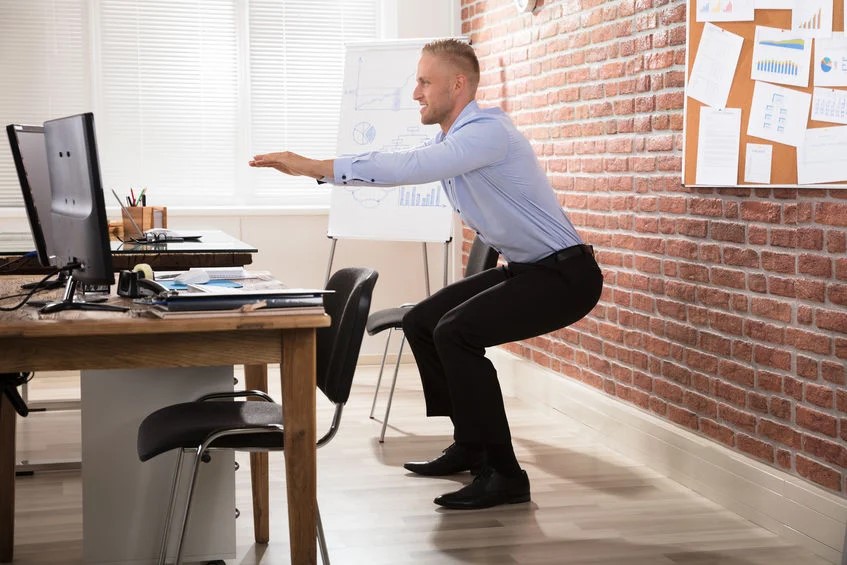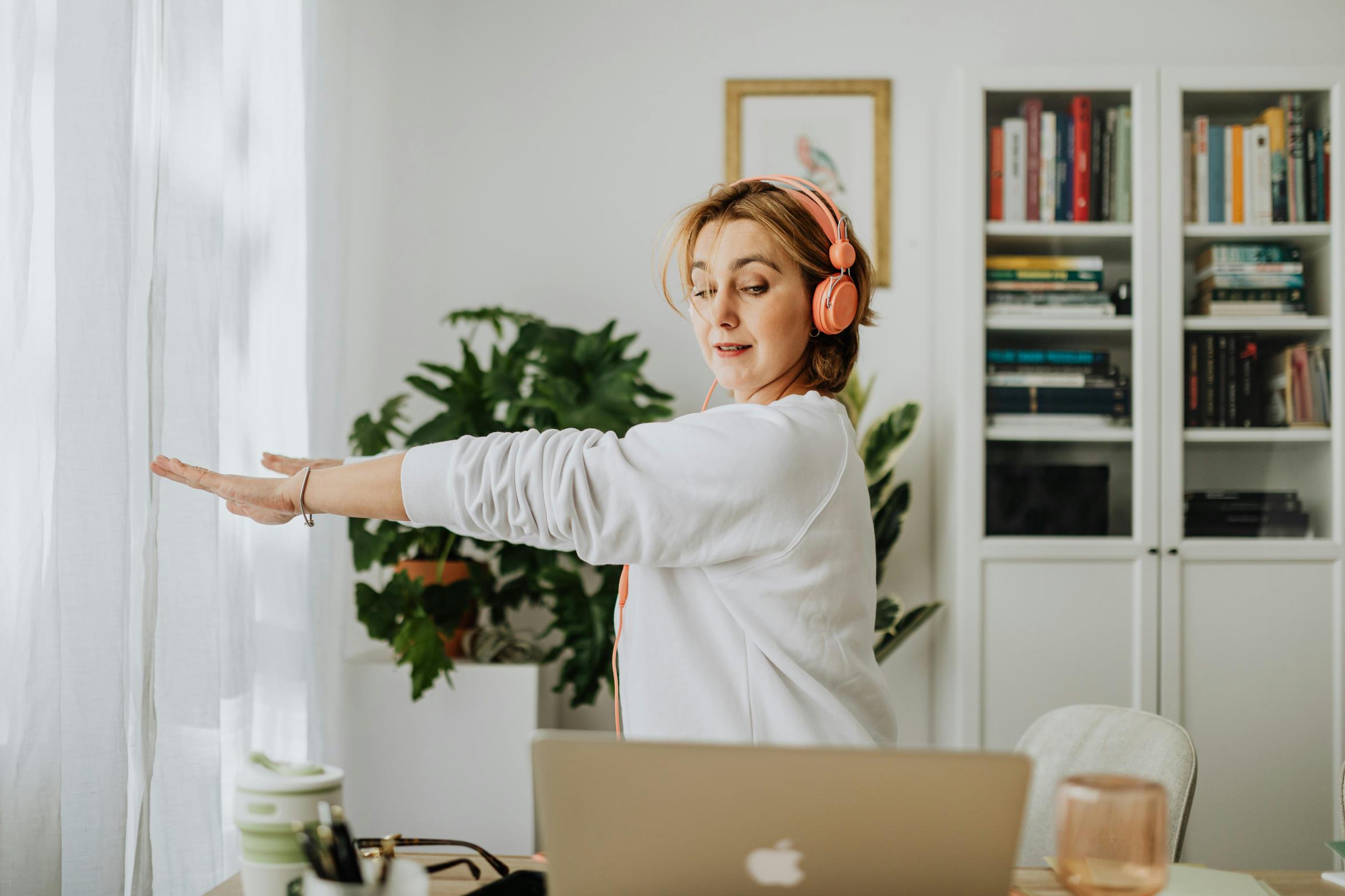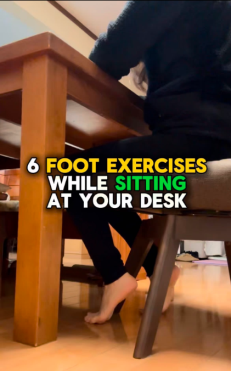Maximizing Training Time: 5 Essential Desk-Based Workouts for Triathletes
 Karen Parnell
April 01, 2025
Karen Parnell
April 01, 2025
Desk-Based Mobility and Strength Routines
As a triathlete, balancing training with work and daily responsibilities can make incorporating strength and mobility exercises challenging. Prolonged periods of sitting, common in desk jobs, can lead to muscle tightness, poor posture, and decreased mobility, all of which can hinder athletic performance and increase injury risk.
However, integrating simple desk-based exercises into your daily routine can help counteract these negative effects, enhancing your performance in swimming, cycling, and running.

Photo by: Power Life
Get your FREE Guide to Desk Based Exercise and Workout Playing Cards
The Impact of Prolonged Sitting on Triathletes
Triathlon demands full-body endurance, strength, and coordination. Sitting for long hours can lead to tight hip flexors, weak glutes, stiff ankles, and poor posture—all of which can negatively affect your biomechanics. Research has shown that prolonged sitting weakens postural muscles and limits mobility, leading to inefficiencies in movement and increased injury risk.
A meta-analysis published in Sports Medicine found that acute exposure to prolonged sitting results in significant vascular dysfunction in the lower limbs but that interrupting sitting periods with activities like aerobic exercises or simple resistance activities can prevent this dysfunction (Paterson et al., 2020).
Another study published in Medicine & Science in Sports & Exercise highlighted that prolonged, uninterrupted sitting impairs vasodilatory function in leg arteries, potentially reducing athletic performance (Carter et al., 2017).
1. Foot & Ankle Activation Routine (Key for Running & Cycling Efficiency)
Sitting for long periods limits blood flow and weakens the small stabilizing muscles of the foot and ankle. This routine enhances circulation and reinforces foot function, crucial for powerful strides and efficient pedal strokes.
Foot and Ankle Desk Exercises:
- Heel Raises – Lift your heels off the ground while keeping your toes planted, engaging your calves. Hold for 3 seconds. (3 sets of 10 reps)
- Tib Raises – Lift your toes while keeping heels down, strengthening your anterior tibialis for shock absorption in running. (3 sets of 10 reps)
- Toe Scrunches – With your heels on the ground and foot lifted scrunch your toes to engage foot muscles, hold then relax. (3 sets of 10 reps)
- Toe Yoga – Lift big toes while keeping others down, then lift toes with big toe down. Improves foot coordination and arch strength. (3 sets of 10 reps per movement)
- Foot Circles – Extend one leg and draw circles with your foot to mobilize the ankle. (10 reps each direction per foot)
Why it works: Foot and ankle strength are crucial for running efficiency, cycling power, and injury prevention. Weak or stiff feet can lead to poor shock absorption, reduced propulsion, and increased risk of injuries like Plantar Fasciitis or Achilles tendinopathy. Since desk work limits foot movement, these exercises help maintain mobility and strength throughout the day.
How to do the Foot Exercises: Watch on Instagram from The Foot Collective
2. Neck & Shoulder Mobility Routine (Key for Swim Stroke & Posture)
Desk work often leads to forward head posture and rounded shoulders, which can impair swim stroke efficiency and breathing mechanics. This routine helps maintain shoulder stability and neck mobility.
Neck and Shoulder Desk Exercises:
- Neck Nods & Rotations – Rotate your head to the left then slowly nod “yes” up and down three times then do the same on the right side and to loosen stiff neck muscles. Make sure to only turn your head and not the rest of your body. Keep your back straight during the exercise. (Repeat 2-3 times)
- Shoulder Rolls – Roll shoulders backward and forward to reduce tension. (10 reps each way)
- Desk Angels – Sit tall, press back against the chair, and move arms up and down like a snow angel to strengthen shoulder stabilizers. (1-3 sets of 10 reps)
- Thoracic Extensions – Sit tall, place hands across your chest head, and gently arch backward to improve mid-back mobility. (1-3 sets of 10 reps)
- Seated Cat-Cow Stretch– Sit tall with hands on your knees. Exhale as you round your back, tucking your chin to your chest (Cat). Inhale as you arch your back, lift your chest, and look slightly upward (Cow). Flow between these positions with control. (10-15 reps)
Why it works: These movements counteract poor posture caused by prolonged sitting, keeping the neck, shoulders, and upper back mobile. A more open chest and flexible spine improve swim stroke mechanics, breathing efficiency, and overall movement fluidity.
Get your FREE Guide to Desk Based Exercise and Workout Playing Cards
3. Hip & Quad Mobility Routine (Key for Running Stride & Cycling Power)
Sitting shortens the hip flexors and weakens the glutes, leading to poor running and cycling mechanics. This routine helps counteract tightness and promotes better movement efficiency.
Hip and Quad Desk Exercises:
- Seated Hip Flexor Stretch – Sit on the edge of the chair, extend one leg back as if you were kneeling in a 90-90 position, and hold for 30 seconds per side.
- Seated Figure-Four Stretch – Cross one ankle over the opposite knee and lean forward to open hips. Hold for 20-30 seconds per side.
- Standing Quad Stretch – This one you will need to stand up for and stand beside your desk. Grab one ankle, pull it towards the glutes, and hold. (30 seconds per side)
- Seated Glute Squeeze – Contract glutes while sitting to activate muscles weakened by prolonged sitting. Hold for 5 seconds. (10 reps)
- Seated Adductor Stretch – Sit with feet wider than hip-width, place elbows on your knees, and gently press outward to stretch the inner thighs. (30 seconds per side)
Why it works: Tight hips and weak glutes reduce stride efficiency, cycling power, and overall movement mechanics. This routine improves flexibility, activates key muscles, and reduces stiffness, helping triathletes move more efficiently and reduce injury risk.
Get your FREE Guide to Desk Based Exercise and Workout Playing Cards
4. Core & Glute Activation Routine (Key for Stability in All Three Disciplines)
A strong core supports efficient movement across swimming, biking, and running. Desk-based core work enhances posture and power output.
Core and Glute Desk Exercises:
- Seated Pelvic Tilts – Tilt pelvis forward and back to engage deep core muscles. (10 reps)
- Seated Knee Lifts – Lift one knee toward the chest, engaging lower abs then lower. If this is easy then you can hold at the top for 3-5 seconds. (1-3 sets of 10 reps per leg)
- Isometric Glute Squeeze – Squeeze glutes while sitting, hold for 5 seconds. (10 reps)
- Seated Oblique Twists – With arms crossed, rotate torso side to side, slow and controlled. (3 sets of 10 reps per side)
- Seated Marches – Alternate lifting knees in a controlled march to improve core stability and hip flexor strength. Engage your core throughout. (3 sets of 20 marches)
Why It Works: A weak core and inactive glutes lead to poor posture, reduced power, and inefficient movement patterns in all three triathlon disciplines. This routine engages key stabilizing muscles, enhances balance, and supports better posture, leading to improved endurance and injury prevention.
Get your FREE Guide to Desk Based Exercise and Workout Playing Cards
5. Desk-Based Strength Routine (Key for Full-Body Strength & Stability)
Triathletes need functional strength to support endurance training. This routine incorporates bodyweight exercises that can be done using your desk, chair, or the floor to build strength without needing a gym.
Strength Desk Exercises:
- Desk Push-Ups – Place hands on the edge of the desk, step back, and perform push-ups to strengthen the chest, shoulders, and triceps. (3 sets of 10 reps)
- Air Squats– Stand up from your chair without using your hands, then slowly lower back down. Great for quad, hamstring, and glute activation. (3 sets of 12 reps)
- Desk Triceps Dips– Sit on the edge of a sturdy chair, grip the seat, and lower yourself down before pushing back up to target the triceps. (3 sets of 10 reps)
- Wall Sit– Lean against a wall with knees at a 90-degree angle and hold to build lower body endurance. (Hold for 30-60 seconds, 3 rounds)
- Seated Calf Raises– Press through the balls of your feet to lift your heels while seated, strengthening the calves. (3 sets of 15 reps)
- Plank Hold (Floor or Desk)– Hold a plank on the floor or place hands on the desk for a modified version to engage the core and upper body. You can do this on your hand or elbows. (2-3 rounds of 20-45 seconds)
Why it works: These exercises strengthen key muscle groups needed for endurance sports, improve muscular endurance, and help maintain stability, all while fitting seamlessly into a busy workday.
Get your FREE Guide to Desk Based Exercise and Workout Playing Cards
Conclusion: Benefits of Desk Based Exerices for Triathletes
Triathletes thrive on efficiency—both in training and life. These desk-friendly exercises help maintain mobility, strength, and posture without disrupting your work schedule. By integrating these micro-routines into your day, you counteract the negative effects of prolonged sitting, ensuring that when you hit the pool, saddle, or pavement, your body is primed for peak performance.
Try incorporating at least one of these routines daily and notice how small changes lead to big improvements in how you move and feel. Your next personal best starts right at your desk!
Karen Parnell is a Level 3 British Triathlon and IRONMAN Certified Coach, 8020 Endurance Certified Coach, WOWSA Level 3 open water swimming coach and NASM Personal Trainer and Sports Technology Writer.
Karen is currently studying for an MSc in Sports Performance Coaching at the University of Stirling.
Need a training plan? I have plans on TrainingPeaks and FinalSurge:
I also coach a very small number of athletes one to one for all triathlon and multi-sport distances, open water swimming events and running races, email me for details and availability. Karen.parnell@chilitri.com
Get your FREE Guide to Desk Based Exercise and Workout Playing Cards
Get your FREE Guide to Running Speed and Technique
Get your FREE Swim Workouts for Triathletes E-book
Get your FREE Open Water Swimming Sessions E-Book
Get you FREE Guide to Strength and Conditioning
FAQ: Desk-Based Mobility and Strength Exercises for Triathletes
1. Why should triathletes do desk-based exercises?
Triathletes often work desk jobs, leading to prolonged sitting, tight muscles, and poor posture. Desk-based exercises help improve mobility, prevent stiffness, and enhance performance in swimming, cycling, and running.
2. How often should I do mobility exercises at my desk?
For optimal benefits, perform a mini-routine every 1-2 hours during the workday. Even 5-10 minutes of movement can improve circulation, reduce stiffness, and keep your muscles engaged.
3. Can desk exercises improve triathlon performance?
Yes! Regular mobility work enhances posture, flexibility, and muscle activation, all of which contribute to better running form, cycling efficiency, and swim stroke mechanics. Preventing stiffness also lowers injury risk.
4. Do desk exercises replace strength training for triathletes?
No, these exercises should supplement regular strength and mobility training, not replace them. They help maintain mobility and circulation throughout the day but don’t provide the same strength stimulus as gym workouts.
5. What are the best mobility exercises for triathletes at a desk?
Some of the most effective desk-friendly exercises include:
- Heel raises and tib raises (for running & cycling power)
- Toe yoga and scrunches (for foot and ankle strength)
- Neck nods and shoulder rolls (for better swimming posture)
- Seated hip flexor stretches (to counteract tightness from sitting)
- Seated knee lifts and glute squeezes (for core and lower-body activation)
6. Can I do these exercises without equipment?
Yes! All exercises can be done with just your body weight. If you want to level up, use a small resistance band or a lacrosse ball for additional mobility work.
7. How do I stay consistent with desk-based exercises?
Set reminders on your phone, use a smartwatch with movement alerts, or schedule exercises after meetings or water breaks. Creating habits around these movements ensures long-term consistency.
8. What if I feel pain during these exercises?
Mild discomfort is normal, but pain is a red flag. Stop the exercise immediately and assess your form. If pain persists, consult a sports therapist or physical therapist.
9. Are desk mobility exercises useful for non-triathletes?
Absolutely! Anyone who spends long hours at a desk can benefit from improved posture, mobility, and circulation. These exercises help reduce stiffness, improve focus, and boost overall well-being.
References
Paterson, C., Fryer, S., Zieff, G., Stone, K., Credeur, D. P., Barone Gibbs, B., Padilla, J., Parker, J. K., & Stoner, L. (2020). The effects of acute exposure to prolonged sitting, with and without interruption, on vascular function among adults: A meta-analysis. Sports Medicine, 50(11), 1929-1942. https://pubmed.ncbi.nlm.nih.gov/32757163/
Carter, S., Hartman, Y., Holder, S., Thijssen, D. H. J., & Hopkins, N. D. (2017). Sedentary Behavior and Cardiovascular Disease Risk: Mediating Mechanisms. Medicine & Science in Sports & Exercise, 45(2), 80–86. https://pubmed.ncbi.nlm.nih.gov/28118158/

Photo By: Kaboompics.com

